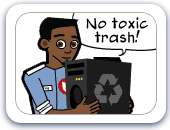Shortcuts:.
Learn more about Green Computing in Trey's blog archives:
Computers impact the environment in a number of ways. Making computers requires non-renewable resources and creates manufacturing waste and pollution. Using computers requires electricity and generates heat, which is also a form of pollution. Disposing of computers creates even more trash and is potentially hazardous because of the materials in the computer.
The goal of green computing is to reduce the environmental impact of computers for both the user and the manufacturer by making computers as energy efficient as possible, reducing the amount of hazardous and non-recyclable materials, and properly disposing of old machines.
Practicing Green Computing
Here you will find information about the environmental issues related to computers and the Internet and tips for what you can do to help reduce your environmental impact.

Environmental Issues
Computers and the Internet have both helped and harmed the environment.

Being Green
Being environmentally friendly when buying, using or disposing of electronics.

Reducing Waste
Tips for reducing the wasteful by-products of using computers and the Internet.
Green Computing Database
These and other cyber definitions can be found in the Cyberpedia.
N
Non-Renewable Resources
A natural resource that cannot be produced, grown, or generated, such as coal, oil, and precious metals. There is a fixed amount of them on the planet, and once they have been used up there will be no more.
Learn more: Green Computing
T
Technotrash
Also called electronic waste or e-waste, any broken or unwanted electrical or electronic device. Technotrash contains toxic and non-biodegradable materials that are very unsafe for the environment, and it has to be disposed of using special methods.
Learn more: Environmental Issues
Toxic
Something that can damage a living organism.
Learn more: Environmental Issues
V
Vampire Power
Electricity consumed by electronic devices when they are switched off or in stand-by mode. Sometimes, this is to keep a digital clock running or power lights on.
Learn more: Computers and Electricity Usage
B
Biodegradable
Able to be decomposed, or broken down, over time in the environment by bacteria or other organisms. Biodegradable materials are less harmful to the environment.
Learn more: Environmental Issues
C
Carbon Emissions
Two of the most harmful greenhouse gasses, they are mostly carbon dioxide and carbon monoxide. They are released into the atmosphere by things like cars, airplanes, power plants and factories.
Learn more: Environmental Issues
E
Environmental Impact
The result of anything that changes the environment, like using resources that the earth cannot replace (such as oil and coal) or producing harmful products (such as waste and pollution).
Learn more: Environmental Issues
G
Global Warming
The increase of the average surface temperature of the planet and the scientific theory that it will continue to increase. Some scientists believe that human-made pollution, like carbon emissions, is contributing to global warming.
Learn more: Environmental Issues
Green Computing
A philosophical approach to computers where the goal is to reduce the environmental impact of both the user and the manufacturer. This includes making computers as energy efficient as possible, using materials that can be recycled or are biodegradable, and using fewer toxic materials and disposing of them safely.
Learn more: Green Computing
Greenhouse Gasses
Gasses in the atmosphere that trap and reflect heat and radiation back to the planet's surface. It is believed that over the last century, the amount of greenhouse gasses in the atmosphere has increased because of more carbon emissions, and that this is contributing to global warming.
Learn more: Environmental Issues
Greenwashing
When companies claim their products are environmentally safe to get people to buy them, even if they really aren't. The term comes from the words "green," which means environmentally friendly, and "whitewashing," which means twisting words to cover up a mistake or an unwanted result.
Learn more: Being Green
Trey's Green Tips
Tip #1: Don't trash, donate!
Donate or sell your old electronics to a charity instead of throwing them away. If you have old games or programs that you don't use anymore, consider taking them to a used game or book store and trading them in for other games, or even giving them to a friend.
Tip #2: Take Proper Care of Technotrash
Instead of throwing toxic technotrash in with the rest of the household garbage, take it to a recycling center or ship it to a company that specializes in disposing of technotrash, like GreenDisk.
Tip #3: Don't Waste Energy
Turn off your electronics when you aren't using them. Because some electronics still use power even when turned off, you can plug them into a power strip or surge protector and switch the whole thing off. Limiting the number of peripheral devices you use with your computer can reduce how much electricity it needs. Try to avoid leaving them plugged into the computer and turned on when not in use.
Tip #4: Don't Waste Materials
To help reduce the amount of trees that get cut down, try not to waste paper. Think twice before printing something, get as much use out of your paper as possible, and recycle it when you're finished with it. If you have the option, choose a downloadable version of a game rather than buying the box version to reduce waste. For hard-to-find items, shopping online is better for the environment because the overall carbon emissions from transporting goods is much less.
Tip #5: Buy Recycled
In addition to recycling, you can further help the environment by buying products made from recycled materials. Look for products that say they are made of post-consumer waste.
Tip #6: Choose Energy-Efficiency
When buying electronics, choose more energy efficient options to both save money and reduce your environmental impact. Laptop computers, LCD, or liquid crystal display monitors, and ink-jet printers use less energy than their counterparts. Look for appliances and electronics with the Energy Star label. They use 30% to 75% less electricity than a standard product.
Tip #7: Choose Less Toxic, Recyclable Products
Try to learn as much as you can about how things are made and what toxic chemicals are bad for your health, so you know what to watch out for when shopping for greener options. Some websites, such as ToxTown, have lots of information on the chemicals in your environment.
Tip #8: Choose Greener Companies
Some companies are further along than others in transitioning to greener, more environmentally friendly manufacturing and recycling processes. Before buying a new device, do a little homework to find out which company you would rather support.
Tip #9: Watch Out For Greenwashing
Watch out for greenwashing. Sometimes companies try to make you think they are more environmentally friendly than they really are. Web sites like GreenwashingIndex.com and StopGreenwash.org can help you uncover the truth.

